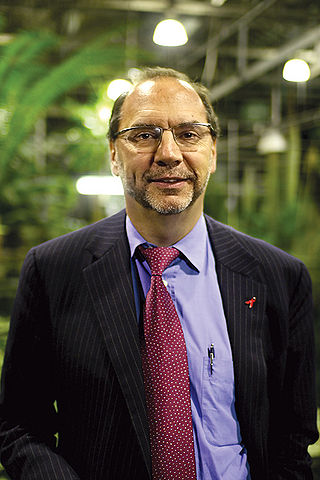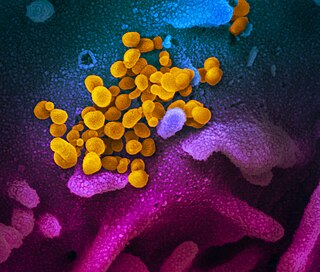Related Research Articles

A pandemic is an epidemic of an infectious disease that has spread across a large region, for instance multiple continents or worldwide, affecting a substantial number of individuals. Widespread endemic diseases with a stable number of infected individuals such as recurrences of seasonal influenza are generally excluded as they occur simultaneously in large regions of the globe rather than being spread worldwide.
Biosecurity refers to measures aimed at preventing the introduction and/or spread of harmful organisms intentionally or unintentionally outside their native range and/or within new environments. In agriculture, these measures are aimed at protecting food crops and livestock from pests, invasive species, and other organisms not conducive to the welfare of the human population. The term includes biological threats to people, including those from pandemic diseases and bioterrorism. The definition has sometimes been broadened to embrace other concepts, and it is used for different purposes in different contexts.

An epidemic is the rapid spread of disease to a large number of hosts in a given population within a short period of time. For example, in meningococcal infections, an attack rate in excess of 15 cases per 100,000 people for two consecutive weeks is considered an epidemic.

Sir Peter Karel, Baron Piot, is a Belgian-British microbiologist known for his research into Ebola and AIDS.

Flu season is an annually recurring time period characterized by the prevalence of an outbreak of influenza (flu). The season occurs during the cold half of the year in each hemisphere. It takes approximately two days to show symptoms. Influenza activity can sometimes be predicted and even tracked geographically. While the beginning of major flu activity in each season varies by location, in any specific location these minor epidemics usually take about three weeks to reach its pinnacle, and another three weeks to significantly diminish.

Harvey Vernon Fineberg is an American physician. A noted researcher in the fields of health policy and medical decision making, his past research has focused on the process of policy development and implementation, assessment of medical technology, evaluation and use of vaccines, and dissemination of medical innovations. Fineberg has held several prominent positions over the course of his career, including Dean of the Harvard School of Public Health, Provost of Harvard University, and President of the Institute of Medicine, now the National Academy of Medicine.
Globalization, the flow of information, goods, capital, and people across political and geographic boundaries, allows infectious diseases to rapidly spread around the world, while also allowing the alleviation of factors such as hunger and poverty, which are key determinants of global health. The spread of diseases across wide geographic scales has increased through history. Early diseases that spread from Asia to Europe were bubonic plague, influenza of various types, and similar infectious diseases.

In public health, social distancing, also called physical distancing, is a set of non-pharmaceutical interventions or measures intended to prevent the spread of a contagious disease by maintaining a physical distance between people and reducing the number of times people come into close contact with each other. It usually involves keeping a certain distance from others and avoiding gathering together in large groups.
Frederick M. "Skip" Burkle, Jr. is an American physician known for his work in human rights, international diplomacy and peacemaking, humanitarian assistance, and disaster response. He has been called "the single most talented and experienced post-conflict health specialist working for the United States government." His medical qualifications include pediatrics, emergency medicine, psychiatry, public health, and tropical medicine.

Ashish Kumar Jha is an Indian-American general internist physician and academic who served as the White House COVID-19 response coordinator from 2022–2023. He has been Dean of the Brown University School of Public Health since 2020. Prior to Brown, he was the K.T. Li Professor of Global Health at Harvard T.H. Chan School of Public Health, faculty director of the Harvard Global Health Institute, and a Senior Advisor at Albright Stonebridge Group. Jha is recognized as one of the leading health policy scholars in the nation. Jha's role at Brown University focuses on improving the quality and cost of health care, and on the impact of public health policy.

Disease X is a placeholder name that was adopted by the World Health Organization (WHO) in February 2018 on their shortlist of blueprint priority diseases to represent a hypothetical, unknown pathogen that could cause a future epidemic. The WHO adopted the placeholder name to ensure that their planning was sufficiently flexible to adapt to an unknown pathogen. Director of the US National Institute of Allergy and Infectious Diseases Anthony Fauci stated that the concept of Disease X would encourage WHO projects to focus their research efforts on entire classes of viruses, instead of just individual strains, thus improving WHO capability to respond to unforeseen strains. In 2020, experts, including some of the WHO's own expert advisors, speculated that COVID-19, caused by the SARS-CoV-2 virus strain, met the requirements to be the first Disease X.
Dr. Daniel R. Lucey is an American physician, researcher, clinical professor of medicine of infectious diseases at Geisel School of Medicine at Dartmouth, and a research associate in anthropology at the Smithsonian National Museum of Natural History, where he has co-organised an exhibition on eight viral outbreaks.
Dan Hung Barouch is an American physician, immunologist, and virologist. He is known for his work on the pathogenesis and immunology of viral infections and the development of vaccine strategies for global infectious diseases.
The Stop Mandatory Vaccination website and associated Facebook group are some of the major hubs of the American anti-vaccination movement. It was established by anti-vaccination activist Larry Cook in 2015.
Maimuna (Maia) Majumder is a computational epidemiologist and a faculty member at Harvard Medical School and Boston Children's Hospital's Computational Health Informatics Program (CHIP). She is currently working on modeling the spread of the COVID-19 pandemic.

The 1957–1958 Asian flu pandemic was a global pandemic of influenza A virus subtype H2N2 that originated in Guizhou in Southern China. The number of excess deaths caused by the pandemic is estimated to be 1–4 million around the world, making it one of the deadliest pandemics in history. A decade later, a reassorted viral strain H3N2 further caused the Hong Kong flu pandemic (1968–1969).
Sotiris Tsiodras is a Greek internal medicine physician, specializing in infectiology, in charge of Greece's management of the coronavirus SARS-CoV-2 crisis.
Sylvie Champaloux Briand is a French physician who is Director of the Pandemic and Epidemic Diseases Department at the World Health Organization. Briand led the Global Influenza Programme during the 2009 swine flu pandemic. During the COVID-19 pandemic, Briand launched the WHO Information Network for Epidemics which looked to counter the spread of COVID-19 misinformation.
Abraar Karan is an American global health physician and researcher. He was active in the COVID-19 epidemic response in Massachusetts and involved nationally through his contributions to lay press media platforms. He is a columnist at the British Medical Journal, a contributor at the National Public Radio, and regularly writes in the lay press.
Ann Marie Kimball is an American physician. She is known for being the pioneer of electronic disease surveillance for infectious disease outbreaks and pandemics. She is currently a Professor Emerita in the Department of Epidemiology at the University of Washington, a Consulting Fellow at the Chatham House Royal Institute of Foreign Affairs, and was a Strategic Consultant in Global Health at the Rockefeller Foundation. Kimball served as a technical and strategic lead for the Bill and Melinda Gates Foundation infectious disease surveillance strategy formation.
References
- 1 2 3 4 Spinney, Laura (1 March 2020). "Epidemics expert Jonathan Quick: 'The worst-case scenario for coronavirus is likely'". The Observer. ISSN 0029-7712 . Retrieved 2020-03-01– via www.theguardian.com.
- ↑ MacKenzie, Debora. "The End of Epidemics: It's all about the money". New Scientist. Retrieved 2020-03-01.
- ↑ Wadman, Meredith (30 January 2018). "Review: How to Achieve 'The End of Epidemics'". Wall Street Journal. ISSN 0099-9660 . Retrieved 2020-03-01– via www.wsj.com.
- 1 2 3 "Jonathan Quick". WHO. Archived from the original on October 21, 2014. Retrieved 2020-03-01.
- ↑ "January 2018". globalhealth.harvard.edu. Retrieved 2020-03-01.
- ↑ "A century ago, the Spanish flu killed 100 million people. Is a new pandemic on the way?". www.newstatesman.com. 21 April 2018. Retrieved 2020-03-01.
- ↑ "Jonathan D. Quick". Duke Global Health Institute. Retrieved 2020-03-01.
- ↑ "WHO | Jonathan Quick". Archived from the original on October 21, 2014.